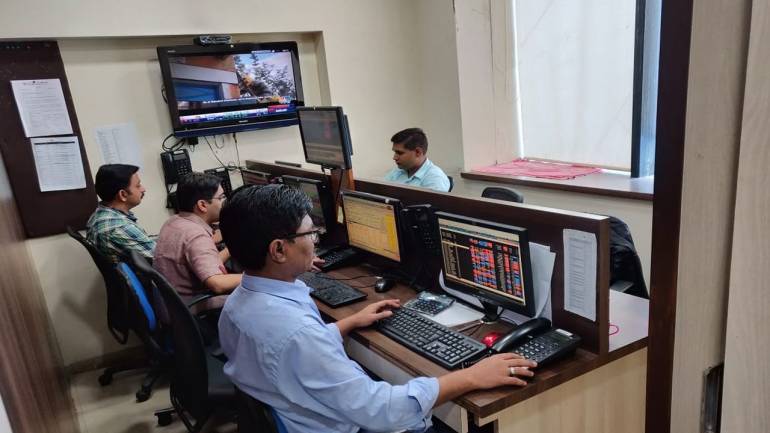Shabbir Kayyumi of Narnolia Financial Advisors said the Head and Shoulders pattern is one of the most reliable and accurate chart pattern
Shabbir Kayyumi
Narnolia Financial Advisors
Basics of Technical Analysis: Part 14
The head and shoulders chart pattern is popular and easy to spot pattern. Chart patterns can be powerful when understood correctly; however they are the foundational building blocks of technical analysis. Patterns don’t form randomly, but are formed due to supply &demand dynamics &decisions traders take in certain situations.
What is Head & Shoulders Pattern?
 Figure .1. Illustration of Head & shoulders Chart Pattern
Figure .1. Illustration of Head & shoulders Chart Pattern
A Head and Shoulders reversal pattern forms after an uptrend, and its completion marks a trend reversal to downtrend. H&S patterns are an integral part of technical analysis, but successful traders combine these techniques with technical indicators and other forms of technical analysis to maximise their odds of success.
 Figure .2. Formation of Head& shoulders Chart Pattern
Figure .2. Formation of Head& shoulders Chart Pattern
The image above is a sketch of the Head and Shoulders chart pattern. The tops at (1), (2), and (3) create the three important swing points of the pattern.
•> Top (1) corresponds to the first shoulder of the pattern.
•> Top (2) is the “head” of the pattern.
•> Top (3) corresponds to the second shoulder of the pattern.
Calculations of target and stop loss Figure .3. Calculations of Target & Stop Loss in H&S Pattern
Figure .3. Calculations of Target & Stop Loss in H&S Pattern
Formation of the H&S Pattern
•> Left shoulder: Price rise to left price peak and followed by a decline.•> Head: Price rise again forming a higher peak, higher than left shoulder.
•> Right shoulder: A decline occurs once again, followed by a rise forming the right peak which is lower than the head.
Again, formations are rarely perfect. There may be some market noise between the respective shoulders and head. You can see that once the price goes below the neckline it makes a move that is at least the size of the distance between the head and the neckline.
There are some variations of H&S pattern based on steepness or slope of neck line as below.
•> Inclined H&S: Neckline is rising & inclined to some extend (upward slope)•> Declined H&S: Neckline is little declined (downward slope)
•> Double right shoulder H&S: 2 right shoulders formations before giving neck line break down.
•> Double left shoulder H&S: it looks like a normal H&S, however it has 2 left shoulder.
Inverse Head & Shoulders pattern
The bullish variant of the Head and Shoulders pattern is the Inverse Head and Shoulders pattern. An Inverse Head and Shoulders pattern is likely to form after a declining trend and is simply an upside-down version of the regular H&S pattern. Some of the names of this bullish pattern are as below
•> Inverse H&S•> H&S Bottom
•> Bullish H&S
•> Inverted H&S
•> Reverse H&S
Neckline
In the standard head and shoulders pattern, we connect the low after the left shoulder with the low created after the head. A trend line is drawn by connecting these lowest points of the two troughs, which is called as “Neckline".
This trend line is the most important component of H& S pattern. However in an inverse head and shoulders pattern, we connect the high after the left shoulder with the high formed after the head, thus creating our neckline for this pattern, upon breaching it, prices give bullish breakout.
Volume and Chart pattern
Volume can also add further insight while trading these patterns. Volume is invaluable when confirming H&S patterns breaks to upside or downside. If volume isn’t present alongside patterns breakouts, then the resulting trading signal isn’t as reliable. It is observed that false or fake breakout of pattern is witnessed in absent of volume while pattern completion. Figure .4. Volume confirmation while Chart Pattern Breakout
Figure .4. Volume confirmation while Chart Pattern Breakout
Volume is important to consider in bullish breakouts; however one should not give more importance to volume in bearish price patterns, which pushes prices lower.
Timeframes & Head and Shoulders Pattern
These patterns appear on every timeframe and can, therefore, be used by scalpers, day traders, swing traders, positional traders and investors. Head and shoulders patterns occur on all times frames, and can be seen visually. Observing Head and shoulders pattern is more of subjective study; it can be perfect by more practice. Figure 5. H& S Pattern Breakout, on 1 min time frame
Figure 5. H& S Pattern Breakout, on 1 min time frame
However on the higher timeframes daily, weekly, monthly; H& S patterns are the most accurate.
Trading Head & Shoulders Pattern
To trade the Head and Shoulders chart pattern one should follow mentioned steps:
•> Identify a valid H&S pattern on chart and draw each of the three tops that forms the pattern.•> Draw a neck line connecting the two bottoms at the base of the head.
•> Keep alerts or observe a Head and Shoulders breakdown and open a short trade when the prices break the neck line downwards.
•> Put a stop loss above the right shoulder as mentioned earlier (the top, prior to the neck line breakdown).
•> Calculate target price as mentioned above and stay in the trade for a minimum price move and square of or cover short position at target price.
Similar steps to be followed while trading Inverse H&S pattern by buying stock after a neck line breakout and selling position near target price.
Conclusion
•> The Head and Shoulders pattern is one of the most reliable and accurate chart patterns.•> It forms during a bullish trend and has the potential to reverse the uptrend to downtrend on successful break down.
•> Nevertheless most of the time Head and Shoulders are not perfectly shaped, formation cab be slightly tilted upward or downward. At the same time neckline may not be perfectly horizontal; it may be ascending or descending.
•> On many chart patterns, one of the two shoulders may appear broader than the other which is caused by the time involved in the formation of the supply & demand.
Disclaimer: The author is Head - Technical & Derivative Research at Narnolia Financial Advisors. The views and investment tips expressed by investment experts on moneycontrol.com are their own, and not that of the website or its management. Moneycontrol.com advises users to check with certified experts before taking any investment decisions.















